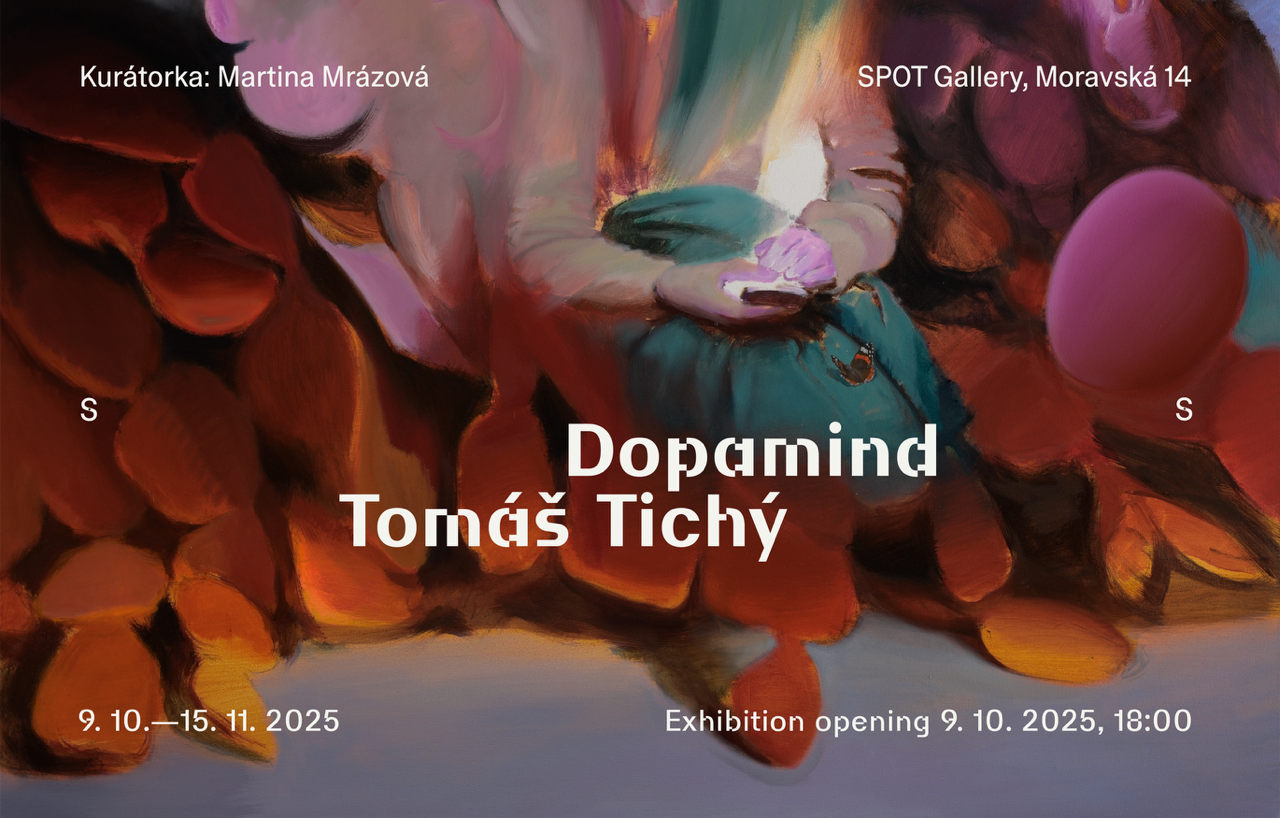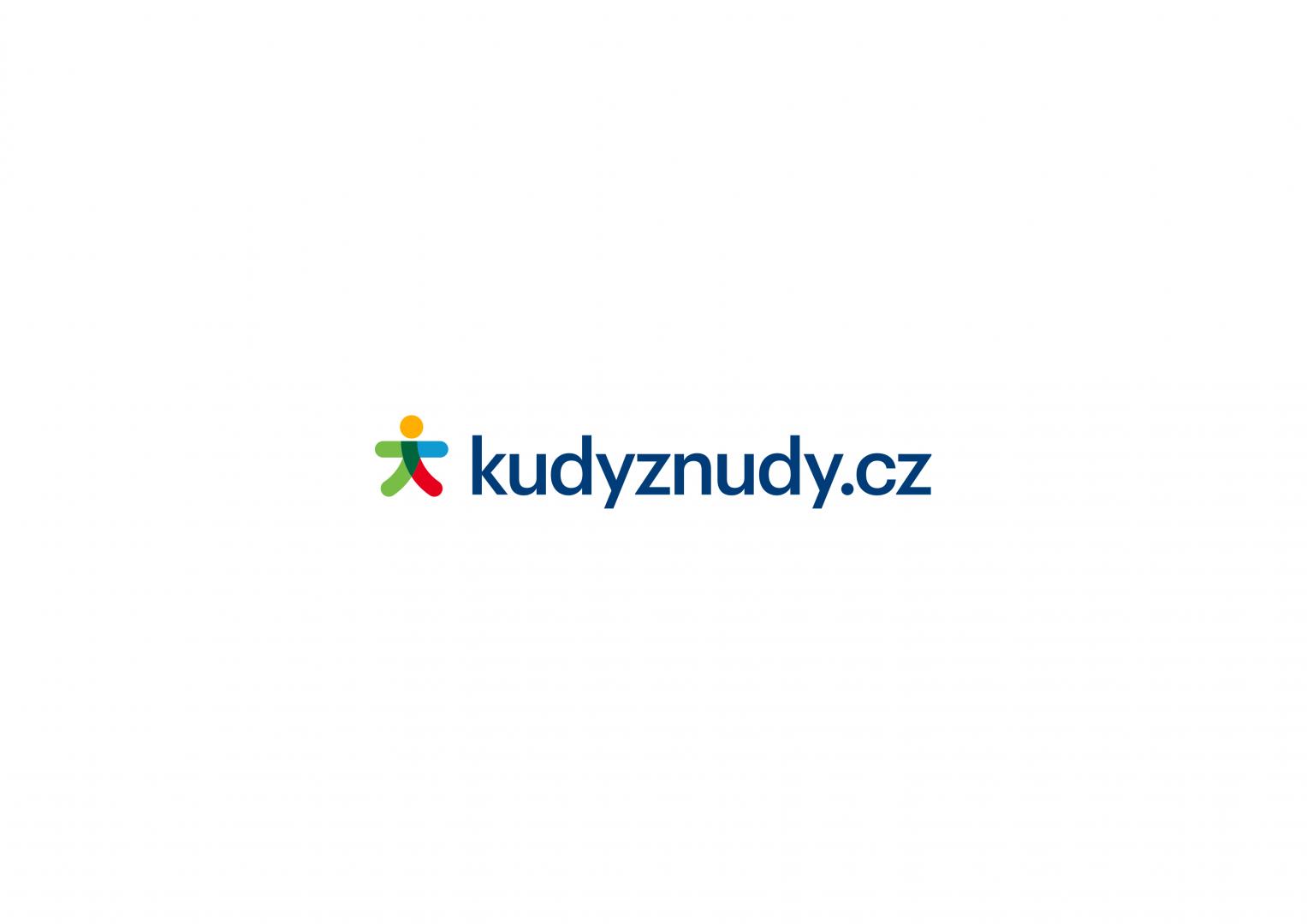Tomáš Tichý, Dopamind
Martina Mrázová
In his artistic practice, Tomáš Tichý mostly presents himself as a figurative painter, reflecting on the position of man and the nature of humanity in the conditions of the current world, as its boundaries with the virtual environment become increasingly blurred. Lately, however, classical figuration has practically disappeared from Tichý’s paintings, as if in an era of easily manipulated reality, overflowing with images of idealised faces, we were losing the notion of what it actually means to be human today. And although humankind remains the basis for the author’s thinking, in his current work, flat, abstract structures seem to have taken over, sometimes revealing only a vague fragment of the human body, like a flash of a distant memory. The paintings are dominated by strange objects, “digital plants”, which the author sees as a visual metaphor for artificial intelligence. The forms of the objects, evoking both the biological process of organic growth and the process of data replication in a virtual environment, have gradually transformed into something like universal painting models, bearing meaning on many different levels – from the principles of human thought and perception, through data flows in the digital sphere, all the way to the cosmological or astrophysical levels.
“Cheap dopamine”, which has been incorporated into the title of the exhibition, is one of the symptoms of today’s digitalised society. From an evolutionary point of view, the dopamine system, responsible for our perception of pleasure, has been necessary for the survival of the human species. Today, however, it is primarily associated with problems of fragmented attention and mental overload, which are caused, among other things, by the use of digital media and social networks. We no longer need to expend much energy to trigger the desired neurochemical reaction in the brain; usually, a simple movement of the hand across a keyboard or touchscreen is enough. The endless stream of visual, auditory, and textual stimuli mediated by digital technologies brings us immediate, powerful rewards that do not last long. The brain therefore demands more and more stimuli, forcing us to consume them repeatedly. However, permanent stimulation of the brain can lead to feelings of exhaustion and has a number of negative effects on our cognitive functions. Attention, memory, and even thinking becomes disrupted, deformed, and sometimes even paralysed (the slang term “brainrot” is often used to describe this state of mind).
Dopamine overload is only one of the many consequences of the blurred boundary between real and virtual space, which has a direct impact on our minds and our relation to the physical world. Every day, we move around in the algorithmic environment of the internet, which expands into a boundless landscape of linked images and information that can easily be multiplied, layered, rearranged, or mutated with a single click. Digital technologies are what brings us the vast amounts of information on which we base our ideas of the world, and we are not always able to verify the truthfulness of the statements we come across. And when digital content is filtered for us through algorithms based on our previous activities, it can easily happen that certain information – often incomplete and possibly untrue – starts to come up repeatedly. As we know from contemporary epistemology, once information begins to spread on a massive scale, it can become sufficiently convincing and credible (this is sometimes referred to as “post-truth”), regardless of its veracity. Information that is incomplete, manipulated or untrue can begin to take on new dimensions, becoming a point of reference based on which a certain group of like-minded people begin to construct an image of the real world and support each other in their distorted view. This creates a self-referencing space that presents itself as objective reality to the outside world.
All the above-mentioned topics come together in Tomáš Tichý’s work. His interest in the manipulated image of reality is expressed not only on a semantic level, but also on a formal one. The author combines classical painting techniques with a range of methods that we may be familiar with from drawing in a virtual environment. He transfers certain principles of digital drawing into painting, including error effects. Using these, he creates new semantic and artistic qualities in his work – thus updating painting as a medium. Tichý systematically works with principles such as replication, layering, and shape reconfiguration, which are commonly used tools in artificial interfaces. He adopts various types of technical moirés, aberration, or subtly graded colour nuances, which create effects of horizontal rippling or blurring in his paintings, similar to those we sometimes see on various screens.
The “digital plants” in Tomáš Tichý’s paintings seem to refer to the real world. At first sight, they look organic and biomorphic, yet they are made up of repeated flat forms that change positions and dimensions and are sticking out of each other as if they were naturally growing out of the body of a single entity. In the Babel series of paintings, the motif of the digital plant takes on sharp shapes that lose their connection to the biological principles of growth and proliferation, further intensifying the feeling of danger. The artificiality and alienation of the objects, which represent a different principle of perception in Tomáš Tichý’s paintings, is also accentuated by deliberately illogical aspects of the construction of space, the fragmentary nature of the depictions, and the incompleteness of some parts of the paintings.
Sometimes, Tichý emphasises the indistinctness of the boundaries between reality and its simulation by painting scenes on the surfaces of the objects, evoking the setting sun or the ruins of a civilization struck by an unspecified catastrophe. The surfaces of the objects then function as a kind of projection screen, breaking through space into other dimensions. Moreover, these scenic depictions sometimes penetrate through the object and its surroundings, as if the boundary between them was only illusory. It is not clear exactly where the object begins and ends, just as today the boundary between artificial intelligence and our own minds is gradually losing its contours.
Realistically painted butterflies and other representatives of the natural world (birds, bumblebees, bees), which appear in his work for the very first time, add another layer of reality to Tichý’s paintings. These fragile and ephemeral symbols of life, which the artist perceives as representatives of humanity, find themselves placed in the harsh, artificial environment of the digital world. Attracted by light, they settle on the mentioned objects as if they were real living plants that could provide them with food and shelter. The artist sometimes subjects his illusory paintings of butterflies to further destructive interventions, which shift them to the level of digital noise or fleeting memories. Tichý thus originally connects the environmental theme with the classic artistic genres of vanitas and memento mori, which remind us of the transience and fragility of life. Instead of the traditional symbols of skulls, hourglasses or wilting flowers, however, he approaches the theme through the clash between the digital and natural worlds, which are increasingly subject to the destructive influences of human activity.
Although the shapes in the paintings sometimes grow out of ruins and can appear threatening, the overall tone of the paintings is harmonious and calming. It’s as if something dangerous and at the same time beautiful and fascinating was growing out of the boundless destruction and attracting the butterflies to rest on it. And in spite of the fact that Tomáš Tichý’s paintings deal with themes of threat, tension, anxiety and emptiness that correspond with the state of today’s society, they do not appear hopeless. His ability to use painterly means, especially colour and light, to balance up dark and difficult topics, is one of the core values of his work.
Certain painting strategies used by Tomáš Tichý bring his work close to that of the Leipzig and Cluj painting schools. Similarly to Mathias Weischer or Corinne Wasmuht, Tichý also constructs pictorial spaces that relate to reality but at the same time expose its illusory, artificial, and alien nature through various unsettling disruptions. The paintings can thus evoke glitches, digital noise, or a broken interface. Compared to the work of the aforementioned artists, however, Tomáš Tichý’s paintings appear significantly calmer and more harmonious. The mysterious atmosphere of unknown worlds, which he has developed especially in his latest, more geometrically conceived paintings, has something in common with the slow-motion shots of cosmic bodies in Nolan's film Interstellar. Tichý’s paintings also evoke a feeling of vast space, in which the passage of time takes place in dimensions completely different from those we are familiar with. However, Tichý ultimately manages to connect this vision of faraway cosmic spheres and parallel spaces through the illusory motif of the butterfly, creating a single continuous universe in which we do not have the answers to some questions, and the imaginative power of mystery remains tantalizingly provocative.
Tomáš Tichý (1984) is one of the most prominent Czech painters of the middle generation. In his work, he combines classical painting techniques with methods used in the digital environment. He has long been exploring the position of man and the transformation of human perception in the digital age. His paintings oscillate between figuration and abstract symbolism.
He has a master’s degree from the Academy of Fine Arts in Prague (Karel Stretti’s painting restoration studio, 2005–2011). In 2009, he completed an internship at the Koninklijke Academie voor Schone Kunsten in Antwerp. He has been nominated for several prestigious art awards, including Wells Art Contemporary, The Columbia Threadneedle Prize, and the CBM Prize.
Since 2005, he has been exhibiting regularly in the Czech Republic and abroad. His recent projects include solo exhibitions at the Regional Museum and Gallery in Most (2025), the Gallery of Fine Arts in Náchod (2018), and The Chemistry Gallery (2022). He was also selected to participate in the After Rembrandt project, which ran in collaboration with the National Gallery in Prague and the Wallraf-Richartz Museum in Cologne from 2016 to 2021.
Abroad, he is represented by CRAG gallery in Turin and by Junge Kunst Berlin.


